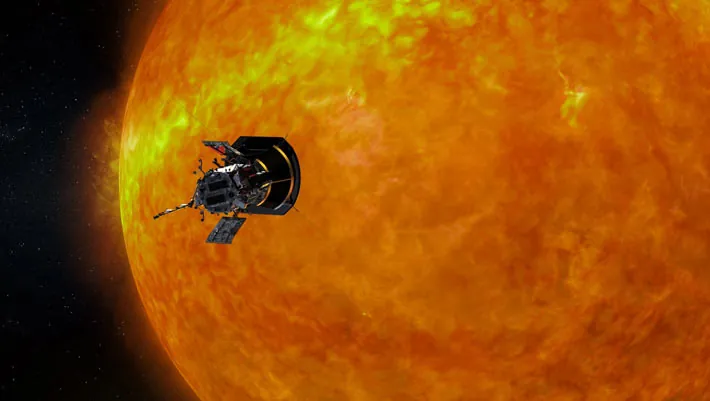
Parker Solar Probe Defies Limits in Historic Sun Encounter
2024-12-30
Author: Noah
Parker Solar Probe Defies Limits in Historic Sun Encounter
In a groundbreaking achievement, NASA’s Parker Solar Probe made its closest-ever approach to the Sun on December 24, 2024, flying just 6.1 million kilometers (3.8 million miles) above the solar surface. The spacecraft reached an astonishing speed of 692,000 kilometers per hour (430,000 miles per hour) — the fastest any human-made object has ever traveled.
Two days after this monumental encounter, mission control received a confirming signal indicating the spacecraft navigated the extreme solar environment successfully and is functioning normally.
To withstand temperatures that can soar to over 500,000 degrees Celsius (1 million degrees Fahrenheit) in the Sun's outer atmosphere, known as the corona, the Parker Solar Probe is equipped with a state-of-the-art carbon foam heat shield. This engineered marvel can endure temperatures up to 1,427 degrees Celsius (2,600 degrees Fahrenheit) while keeping its sensitive instruments cool at around room temperature. During its latest pass, the shield was expected to reach a maximum temperature of about 982 degrees Celsius (1,800 degrees Fahrenheit).
Dr. Nicky Fox, the associate administrator of NASA’s Science Mission Directorate, emphasized the historic significance of this mission, stating, “Flying this close to the Sun is a historic moment in humanity’s first mission to a star.” The data collected from these encounters not only deepens our understanding of the Sun but also sheds light on its effects on technologies used on Earth and beyond, crucial for future space exploration endeavors.
Dr. Nour Rawafi, the project scientist for Parker Solar Probe, remarked on the mission's pivotal role in revolutionizing our comprehension of solar mechanics, declaring, “Parker Solar Probe is braving one of the most extreme environments in space and exceeding all expectations.” Similarly, John Wirzburger, a systems engineer on the mission, pointed out the decades of technological advancement necessary to make this daring mission possible since the concept was first envisaged in 1958.
The Parker Solar Probe's investigation is critical for understanding why the solar corona is so hot, unraveling the origins of solar winds, and uncovering the processes behind the acceleration of energetic particles moving at speeds of up to half the speed of light.
Dr. Kelly Korreck, a program scientist at NASA, underlined the importance of the probe's data, noting, “The data are so important for the science community because it gives us another vantage point.” This firsthand data is expected to transform solar science and enhance our broader understanding of stars throughout the universe.
As of now, the spacecraft has confirmed its safety and the status of its instruments. Soon, it will recover and transmit a wealth of new information gathered during its most recent solar passage. Dr. Joe Westlake, director of the Heliophysics Division at NASA, expressed enthusiasm about the incoming data: “The data that will come down from the spacecraft will be fresh information about a place that we, as humanity, have never been. It’s an amazing accomplishment.”
Looking ahead, Parker Solar Probe has scheduled additional close solar passes on March 22 and June 19, 2025, promising even more exciting opportunities for scientific discovery about our celestial neighbor.
The mission continues to captivate both the scientific community and the public, igniting curiosity about the Sun's intricate workings and our greater universe. Stay tuned – the revelations from this mission could change our understanding of the solar system and beyond forever!



 Brasil (PT)
Brasil (PT)
 Canada (EN)
Canada (EN)
 Chile (ES)
Chile (ES)
 Česko (CS)
Česko (CS)
 대한민국 (KO)
대한민국 (KO)
 España (ES)
España (ES)
 France (FR)
France (FR)
 Hong Kong (EN)
Hong Kong (EN)
 Italia (IT)
Italia (IT)
 日本 (JA)
日本 (JA)
 Magyarország (HU)
Magyarország (HU)
 Norge (NO)
Norge (NO)
 Polska (PL)
Polska (PL)
 Schweiz (DE)
Schweiz (DE)
 Singapore (EN)
Singapore (EN)
 Sverige (SV)
Sverige (SV)
 Suomi (FI)
Suomi (FI)
 Türkiye (TR)
Türkiye (TR)
 الإمارات العربية المتحدة (AR)
الإمارات العربية المتحدة (AR)